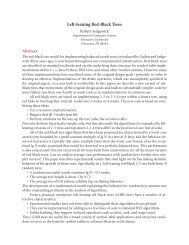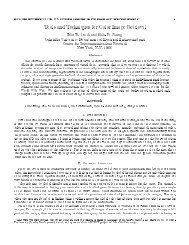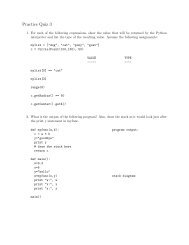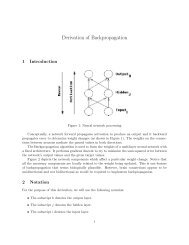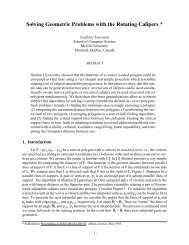Finding Musically Meaningful Words by Sparse CCA
Finding Musically Meaningful Words by Sparse CCA
Finding Musically Meaningful Words by Sparse CCA
You also want an ePaper? Increase the reach of your titles
YUMPU automatically turns print PDFs into web optimized ePapers that Google loves.
Algorithm 1 <strong>Sparse</strong> <strong>CCA</strong> AlgorithmRequire: Symmetric P, Q ≻ 0 and ρ > 01: Choosex 0 ∈ {x : x T Qx ≤ 1} arbitrarily2: repeat3:4: x l+1 = x l ◦ ¯x ∗5: until x l+1 = x l6: return x l , ¯x ∗¯x ∗ = argmin¯xµ¯x T D 2 (x l )¯x − 2x T l [P + µI]D(x l)¯x + ρ||¯x|| 1s.t. ¯x T D(x l )QD(x l )¯x ≤ 1For our purposes Eq. (8) becomes a vocabulary selection mechanism which takes as its input thesemantic and audio feature representations for a set of songs, S and A, and a penalization parameterρ that controls sparsity. The method returns a set of sparse weights w s associated with each word inthe vocabulary. <strong>Words</strong> with a weight of zero are removed from our modeling process.The non-zero elements of the sparse solution vector w s can be interpreted as those words whichhave a high correlation with the audio representation. Thus, in the experiments that follow, settingvalues of ρ and solving Eq. (8) reduces to a vocabulary selection technique.3 Representing Audio and Semantic DataIn this section we describe the audio and semantic representations, as well as describe the CAL500[17] and Web2131 [16] annotated music corpora that are used in our experiments. In both cases, thesemantic information will be represented using a single annotation vector s with dimension equalto the size of the vocabulary. The audio content will be represented as multiple feature vectors{a 1 , ...,a T }, where T depends on the length of the song.The construction of the matrices A and S to solve the sparse <strong>CCA</strong> follows: Each feature vectorin the music corpus is associated with the label for its song. For example, for a given song, weduplicate its annotation vector s for a total of T times so that the song-label pair may be representedas {(s,a 1 ), ..., (s,a T )}. To construct A we stack the feature vectors for all songs in the corpus intoone matrix. S is constructed <strong>by</strong> stacking all the corresponding annotation vectors into one matrix. Ifeach song has approximately 600 feature vectors and we have 500 hundred songs, then both A andS will have about 30,000 rows.3.1 Audio RepresentationEach song is represented as a bag-of-feature-vectors: we extract an unordered set of feature vectorsfor every song, <strong>by</strong> extracting one feature vector for each short-time segment of audio data.Specifically, we compute dynamic Mel-frequency cepstral coefficients (dMFCC) from each halfoverlapping,medium-time (∼743 ms) segment of audio content [9].Mel-frequency cepstral coefficients (MFCC) describe the spectral shape of a short-time audio frameand are popular features for speech recognition and music classification (e.g., [10, 7, 12]). Wecalculate 13 MFCC coefficients for each short-time (23 msec) frame of audio. For each of the 13MFCCs, we take a discrete Fourier transform (DFT) over a time series of 64 frames, normalize <strong>by</strong>the DC value (to remove the effect of volume) and summarize the resulting spectrum <strong>by</strong> integratingacross 4 modulation frequency bands: (unnormalized) DC, 1-2Hz, 3-15Hz and 20-43Hz. Thus, wecreate a 52-dimensional feature vector (4 features for each of the 13 MFCCs) for every 3/4 segmentof audio content. For a five minute song, this results in about 800 52-dimensional feature vectors.3.2 Semantic RepresentationThe CAL500 is an annotated music corpus of 500 western popular songs <strong>by</strong> 500 unique artists.Each song has been annotated <strong>by</strong> a minimum of 3 individuals using a vocabulary of 174 words. Wepaid 66 undergraduate music students to annotate our music corpus with semantic concepts. Wecollected a set of semantic labels created specifically for a music annotation task. We considered4



